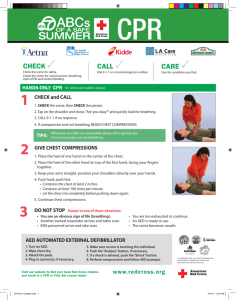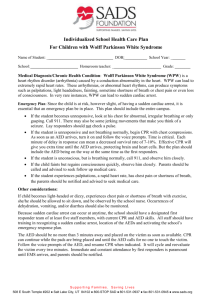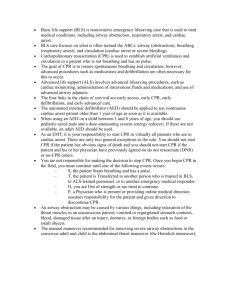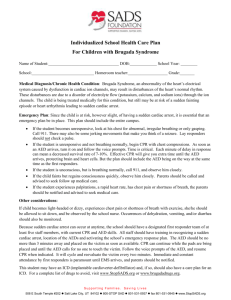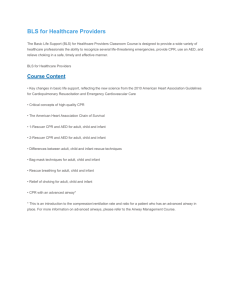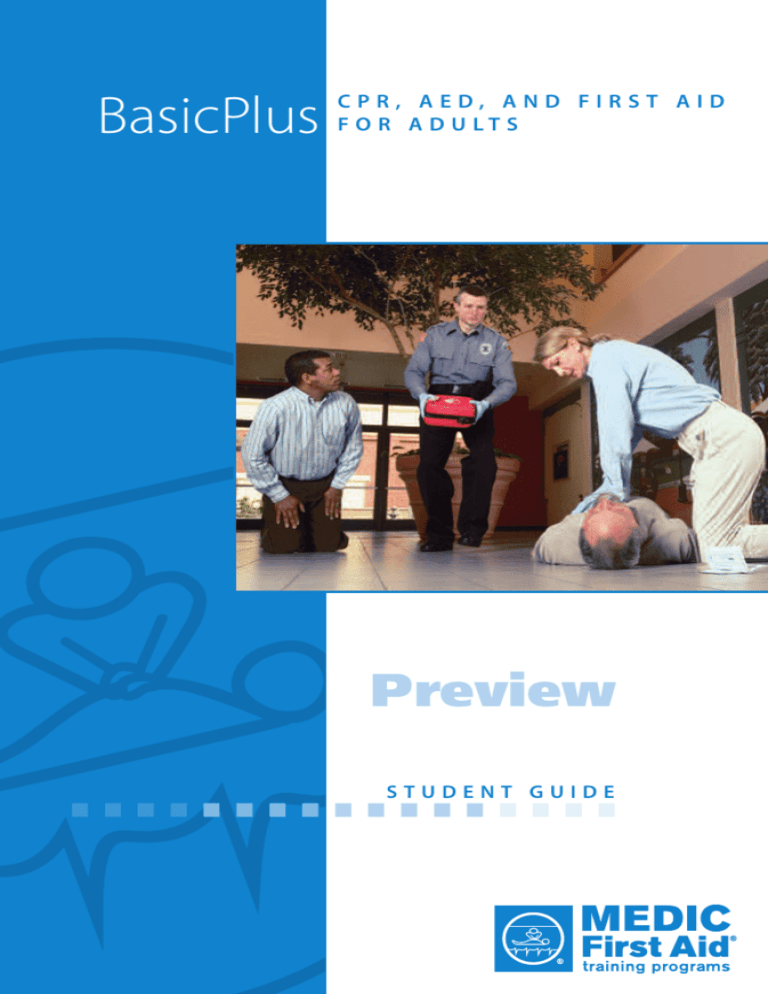
BasicPlus
CPR, AED, AND FIRST AID
F O R A D U LT S
Preview
STUDENT GUIDE
■ ■ ■ ■ ■ ■ ■ ■ ■ ■ ■ ■ ■ ■ ■ ■ ■
MEDIC FIRST AID®
BasicPlus CPR, AED, and First Aid for Adults
■■■■■■■■■■■■■■■■■■■■■■■■■
MEDIC FIRST AID International, Inc.
1450 Westec Drive
Eugene, Oregon 97402
800-800-7099
541-344-7099
e-mail: response@medicfirstaid.com
Visit our Web site at www.medicfirstaid.com
© 2009 MEDIC FIRST AID International, Inc.
All Rights Reserved
First Edition—2007
Notice of Rights
No part of this MEDIC FIRST AID BasicPlus
Version 6.5 Student Guide may be reproduced or transmitted in any form or by any
means, electronic or mechanical, including
photocopying and recording, or by any information storage and retrieval system, without
written permission from the copyright owner.
Trademarks
MEDIC FIRST AID and the MEDIC FIRST AID
logo are registered trademarks of MEDIC
FIRST AID International, Inc.
Chain of Survival image courtesy of the
National Center for Early Defibrillation.
Purpose of this Guide
This MEDIC FIRST AID BasicPlus Version 6.5
Student Guide is solely intended to facilitate
instruction in a MEDIC FIRST AID BasicPlus
CPR, AED, and First Aid training class.
Source Authority
The source authorities for treatment guidelines in the MEDIC FIRST AID Basic Training
Program are:
■ 2005 American Heart Association
Guidelines for CPR and Emergency
Cardiovascular Care; 2005; Circulation;
112(suppl IV).
ISBN 0-940430-33-9
ISBN 978-0-940430-33-4
Version 6.5
■ 2005 International Consensus on
Cardiopulmonary Resuscitation and
Emergency Cardiovascular Care Science
with Treatment Recommendations,
International Liaison Committee on
Resuscitation, Resuscitation, Nov./Dec.
2005, Vol. 67, Nos. 2-3.
■ ASTM Standard F 2171-02: Defining the
Performance of First Aid Providers in
Occupational Settings; 2002; ASTM
International.
■ National Standard Curriculum for
Bystander Care, 1992. National Highway
Traffic Safety Administration, U.S.
Department of Transportation.
■ Other sources of national training and
care guidelines.
This MEDIC FIRST AID BasicPlus Version 6.5
Student Guide is revised as medical consensus
guidelines change.
MEDIC FIRST AID International, Inc.
Development Director
William H. Rowe, BS, FF/EMT-P
Development Team
Corey Abraham, MEd, EMT-B;
Bill Clendenen, MBA; Carolyn Daves;
Michelle Geschke, BA, BFA; John Hambelton;
John Hensel
Technical Consultants
Christopher J. Le Baudour, NREMT-B, MSEd
Zig Sawzak, EMT-P
Medical Director
Richard Abraham, MD
Product No. 5055 (8/09)
Table of Contents
Section Title
■■■■■■■■■■■■■■■■■■■■■■■■■■■■■■■■■
Table of Contents
Role of the First Aid Provider
Emergency First Aid Care ..............
Recognizing an Emergency............
Deciding to Help ............................
Personal Safety ...............................
Using Barriers..................................
2
3
4
5
6
Assessing for Response................... 7
Mechanism for Spinal Injury .......... 8
Activating Emergency Medical
Services (EMS) ............................. 9
Basic Life Support
10
11
12
13
14
15
16
17
18
19
20
Defibrillation
Using an Automated External
Defibrillator (AED)......................
Bare, Prepare, and Place Pads........
Basic AED Operation ......................
Troubleshooting Messages ............
Other AED Considerations .............
31
32
33
34
Caring for Injury
Approaching the Patient
Basic Life-Supporting Skills ............
Airway — Head-Tilt, Chin-Lift .........
Clearing the Airway — Log Roll......
Protecting the Airway —
Recovery Position ..........................
Breathing — Rescue
Ventilations/Mask ..........................
Breathing — Rescue
Ventilations/Shield .........................
Circulation — Chest Compressions..
Initial Assessment ...........................
Unresponsive Patient .....................
CPR for Cardiac Arrest....................
Adult Compression-Only CPR.........
Altered Level of Responsiveness....
Pain, Severe Pressure, or
Discomfort in Chest ....................
Breathing Difficulty, Shortness
of Breath .....................................
Severe Abdominal Pain ..................
21
22
23
24
25
Bleeding and Shock
Control of Bleeding........................ 26
Managing Shock............................. 27
Choking
Foreign Body Airway Obstruction . 28
Continuous Patient Care
Ongoing Assessment ...................... 29
Caring for Illness
Mechanism for Significant Injury .. 35
Swollen, Painful, Deformed Limb.. 36
Specific First Aid Problems
Caring for Specific First Aid
Problems......................................
Performing a Physical
Assessment ..................................
Obtaining a Patient History ...........
Amputation ....................................
Bites and Stings ..............................
Burns ...............................................
Exposure to Heat ............................
Exposure to Cold ............................
Injuries to the Chest .......................
Injuries to the Eyes .........................
Injuries to the Head........................
Injuries to Muscle and Bone ..........
Injuries to Soft Tissue .....................
Impaled Objects..............................
Allergic Reaction ............................
Asthma ............................................
Diabetic Emergencies .....................
Heart Attack ...................................
Poisoning ........................................
Seizure.............................................
Stroke ..............................................
37
38
39
40
41
42
43
44
45
46
47
48
49
50
51
52
53
54
55
56
57
Additional Considerations
Moving Patients.............................. 58
Emotional Impact of Providing
First Aid Care............................... 59
Additional Information
Preventing Disease
Transmission................................ 60
Glossary ........................................... 61
Class Evaluation........................... 63
Warning Signs of Serious Illness .... 30
BasicPlus CPR, AED, and First Aid for Adults
1
Role of the First Aid Provider
■■■■■■■■■■■■■■■■■■■■■■■■■■■■■■■■■
Emergency First Aid Care
W
elcome to the MEDIC FIRST AID® Basic CPR and First Aid training program.
The goal of this program is to help you gain the
knowledge, skills, and confidence necessary to
manage a medical emergency until more advanced
help is available.
Emergency first aid does not require you to
make complex decisions or
have in-depth medical
knowledge. It’s easy to learn,
remember, and perform.
You will become an
important part of a team
of emergency medical care
providers that includes
firefighters, EMTs,
paramedics, hospital
emergency room
personnel, and others.
This program will focus on
your essential responsibilities
as a first aid provider:
■
Recognizing a medical
emergency
■
Making the decision to help
■
Identifying hazards and
ensuring personal safety
■
Activating the
Emergency Medical
Services (EMS) system
■
Providing supportive,
basic first aid care
Your instructor will
use short video
segments, combined
with this student guide, skill demonstrations, and group practices, in an effective, low-stress manner to help you learn.
2
BasicPlus CPR, AED, and First Aid for Adults
Role of the First Aid Provider
■■■■■■■■■■■■■■■■■■■■■■■■■■■■■■■■■
Recognizing an Emergency
R
eal-life emergencies may not be obvious. In many cases, medical emergencies seem to be less serious than they really are. As a first aid provider, the first
step in treating a medical emergency is to suspect one is occurring.
Look for Clues
Learn to recognize visual clues that may indicate a medical emergency has
occurred:
■
A person in an unusual location or body position, such as lying on the
ground
■
A person making strange sounds, movements, or gestures
■
A medical alert bracelet or necklace
■
A vehicle or piece of equipment in an unusual orientation or location
■
Damage to or a change in the environment
■
An odd gathering or small crowd of people
■
A person trying to flag you down or get your attention
BasicPlus CPR, AED, and First Aid for Adults
3
Role of the First Aid Provider
■■■■■■■■■■■■■■■■■■■■■■■■■■■■■■■■■
Deciding to Help
T
he most critical decision you’ll
make is whether to get involved
when you think a medical emergency
has occurred. As you will learn, emergency first aid is based on simple, effective procedures that can be easily
learned and safely applied.
Some of the common reasons why
you might hesitate to help are easily
overcome.
There’s too much to do
You are not alone.
■ You are the first link in a progressive chain of emergency care. Your
goals are to recognize an emergency, ensure everyone’s safety, activate EMS, and provide basic
initial first aid care.
■
Your involvement lasts only until
you are relieved by responding
EMS providers—in most cases, a
very short period of time.
I might make it worse
Basic first aid skills are designed
to do no further harm.
■ You can only help. For example,
when performing cardiopulmonary
resuscitation, or CPR, you cannot
make things worse – you can only
help.
I don’t have a lot of
medical knowledge
You will learn simple yet effective
skills.
■ You will learn basic emergency
skills designed for the non-medical
provider that help to stabilize patients until professional medical
help can arrive.
4
BasicPlus CPR, AED, and First Aid for Adults
Others have already stopped
to help
Always ask if assistance is needed.
■ If EMS has not arrived, assume your
help is needed. Other bystanders
may not have your training.
I’ll get sued if I try to help
Good Samaritan laws provide legal
protection.
■ All states in the United States, and
many other countries, have established Good Samaritan laws to protect you if you stop to help in an
emergency. These laws provide
strong legal protection if you act
prudently and within the scope of
your training.
I need permission to help
Begin by introducing yourself and
your level of training.
■ Always ask a responsive patient for
his consent, or permission, before
helping. Everyone has the right to
refuse care.
■
When a patient is unresponsive,
the legal concept of “implied consent” allows you to help, because
it assumes an unresponsive patient
would give you permission to help
if he were responsive.
Role of the First Aid Provider
■■■■■■■■■■■■■■■■■■■■■■■■■■■■■■■■■
Personal Safety
SETUP
Pro
rotect
tect Self
and Patient
Stop
Environment
Traffic
Unk
nknown
nown
Hazards
Hazards
O
nce you’ve decided to help in an emergency, your first and most important
concern is your own safety. Emergency scenes can be dangerous. If it is not safe
for you, do not enter. Maintain your distance and call for professional help.
SETUP
The acronym SETUP can be a useful tool to help you remember the key
elements of personal safety:
Stop
Unknown hazards
When you see someone who may
need help, pause for a moment before you approach. Look for any obvious hazards. Form an initial
impression of what happened.
This includes dangers that are not
initially apparent. Keep alert for developing hazards. It may be necessary
to retreat from the scene.
Environment
The use of gloves and breathing
barriers is important, because infectious diseases can be transmitted
through open cuts or sores in the
skin or through the mucous membranes of the mouth, nose, and eyes.
The use of protective barriers will
help reduce the risk of exposure to
you and the patient.
Pay attention to your surroundings. Take into account any environmental barriers or dangers that could
endanger you or others.
Traffic
Be extremely careful if you are providing first aid on or near a roadway.
Each year, many people are struck
and killed by motor vehicles while
providing assistance.
Protect yourself and the patient
BasicPlus CPR, AED, and First Aid for Adults
5
Basic Life Support
■■■■■■■■■■■■■■■■■■■■■■■■■■■■■■■■■
Breathing — Rescue Ventilations Using a Mask
Place Mask
■
Inspect the mask to make sure the
one-way valve is in place.
■
Place mask flat on the patient’s face,
laying the top of the mask over the
bridge of the patient’s nose.
Establish an Airway
■
Place palm of your hand on patient’s
forehead and use your thumb and forefinger to control top of the mask.
■
Use thumb of hand lifting patient’s chin
to control bottom of mask.
■
Use head-tilt, chin-lift and bring patient’s face up into mask to create an
airtight seal and establish airway.
Ventilate
■
Take a normal breath and blow
through the valve opening to deliver
ventilation.
■
Breath should be 1 second in length
and have sufficient volume to create
a visible rise of the patient’s chest.
Allow for Exhalation
14
BasicPlus CPR, AED, and First Aid for Adults
■
Remove your mouth and let the patient
completely exhale.
■
Take a fresh breath for the next
ventilation.
Basic Life Support
■■■■■■■■■■■■■■■■■■■■■■■■■■■■■■■■■
Initial Assessment
­Approach Patient
■
Pause. Use SETUP to identify any
hazards.
■
Look for mechanism of serious injury.
■
Introduce yourself and your level of
training. If needed, tap and shout.
■
Activate EMS.
Assess Airway
■
If patient is unresponsive, establish an
open airway using head-tilt, chin-lift.
■
Inspect patient’s mouth.
■
If foreign material is visible in the
mouth, remove it.
Assess Breathing
■
Look for chest rise and fall, listen for
sounds of breathing, and feel for
exhaled air. Assess no longer than
10 seconds.
■
Do not confuse infrequent sighing or
gasping with normal breathing. Consider breathing to be absent.
■
If breathing is absent, perform CPR.
Assess Circulation
■
If patient is breathing, maintain airway
and scan for signs of serious bleeding.
■
Assess patient’s tissue color and skin
temperature for signs of shock.
■
Assess tissue color in patients with
darker skin by looking at their lips or
fingernail beds.
BasicPlus CPR, AED, and First Aid for Adults
17
Caring for Illness
■■■■■■■■■■■■■■■■■■■■■■■■■■■■■■■■■
Pain, Severe Pressure, or Discomfort in Chest
Recognize
■
Chest pain, pressure, or discomfort are
the most common symptoms associated
with serious heart problems.
■
Other signs and symptoms include
light-headedness; shortness of breath;
nausea; or pale, cool, clammy skin.
■
Other serious conditions can also cause
chest pain.
Activate EMS
■
Activate EMS immediately.
■
Comfort patient and keep him as calm
as possible.
Position of Comfort
32
BasicPlus CPR, AED, and First Aid for Adults
■
Allow patient to find the most comfortable position in which to breathe.
■
Be prepared to provide any indicated
care as determined by Ongoing
Assessment.
■
Provide emergency oxygen if available
and you are trained to use it.
Caring for Injury
■■■■■■■■■■■■■■■■■■■■■■■■■■■■■■■■■
Swollen, Painful, Deformed Limb
Recognize
■
Consider the mechanism involved when
assessing the severity of the limb injury.
■
Encourage patient to avoid moving the
injured limb.
Fill the Gaps
■
If available, use padding, such as a
blanket or coat, to fill any gaps beneath the extremity.
Provide Manual Stabilization
36
BasicPlus CPR, AED, and First Aid for Adults
■
Use your hands to help support the
limb until EMS arrives.
■
Splint the injured limb with the gentle
support of your hands.
■
EMS can provide more efficient and effective resources for splinting.
Specific First Aid Problems
■■■■■■■■■■■■■■■■■■■■■■■■■■■■■■■■■
Amputation
An amputation occurs when a body part, typically part of an arm or leg, is
partially or totally detached from the body.
Physical Assessment (DOTS)
Look and feel for:
■ Obvious deformity to the body
part
■ Bleeding wound
Patient History (SAMPLE)
Ask about:
■ Mechanism of injury
■ Pain
Care for the Patient
■
■
■
■
■
■
■
■
Control bleeding with direct
pressure.
Activate EMS without delay.
Treat for possible shock.
Once bleeding has been controlled, locate
the amputated part.
If partially detached, immobilize with a bulky dressing. Do not remove a
partial amputation.
If completely amputated, wrap part in dry, clean or sterile dressing and place
in a dry plastic bag. Put bag in a larger bag or container of ice and water.
Manage shock.
Provide emergency oxygen if it is available and you are trained to use it.
Additional Considerations
■
■
■
■
■
40
Do not soak amputated part in water.
Do not put amputated part directly on ice or allow it to freeze.
Seek professional medical aid as soon as possible to increase chance for
successful reattachment.
Do not waste time looking for body part. It can be sent in separately.
Avoid handling loose teeth by the root ends. Rinse them with clean water,
store in milk, and see a dentist as quickly as possible.
BasicPlus CPR, AED, and First Aid for Adults
■■■■■■■■■■■■■■■■■■■■■■■■■■■■■■■■■
Specific First Aid Problems
Bites and Stings
Early supportive care for poisonous bites and stings can improve the overall
outcome for the patient. Early identification of the marine animal, spider,
snake, or insect involved can help professional medical care providers decide
on the most appropriate advanced treatments.
Physical Assessment (DOTS)
Look and feel for:
■ Obvious bites or stings to the skin
■ Tenderness, swelling
■ Breathing difficulty, wheezing
Patient History (SAMPLE)
Ask about:
■ History of recent bite or sting
■ History of allergic reaction to
bites or stings
Care for the Patient
■
■
Make sure it is safe for you to approach.
Activate EMS if you suspect a severe allergic
reaction. Perform Ongoing Assessment and provide any indicated care.
■
Keep the patient still and at rest in a position of comfort. Immobilize the
affected body part. Remove jewelry before local swelling begins.
■
Wash affected area with mild soap and water.
A patient may carry medication to counteract an allergic reaction. Assist the
patient in taking the prescribed medication.
■
Additional Considerations
■
Consider snake bites to be poisonous until proven otherwise. If safe to do so,
try to determine the size and coloration of the snake. If the snake has been
killed, turn it over to EMS to be identified.
■
The use of ice or a cold pack on an insect sting may be helpful and may provide some pain relief to the patient. Do not apply cold therapy to snakebites.
■
Do not cut or suck on a snakebite wound.
The use of a constricting band in the treatment of snakebites and some
marine animal bites varies among geographic areas. Consult local authority
on the use of a constricting band.
■
■
When providing initial care for a bee sting, scrape stinger off skin surface
with the edge of a credit card or similar device. Do not pinch the protruding
part of the stinger which contains the venom sac.
BasicPlus CPR, AED, and First Aid for Adults
41
Specific First Aid Problems
■■■■■■■■■■■■■■■■■■■■■■■■■■■■■■■■■
Injuries to the Eyes
The eyeball is a complex organ that provides us with sight. Injuries to the eyes
can threaten the ability to see.
Physical Assessment (DOTS)
Look and feel for:
■ Obvious eye injury
■ Redness, watery look to eyes
Patient History (SAMPLE)
Ask about:
■ Mechanism of injury
■ Pain
■ History of eye problems
Care for the Patient
■
■
■
■
■
■
Do not remove impaled objects
imbedded in the eye.
Small foreign bodies that are irritating the eyes can be flushed out with
running water or a sterile saline eyewash solution.
If any objects remain in the eye, do not attempt to remove them. Cover both
of the patient’s eyes with loose dressings.
If chemicals are splashed into the eyes, flush continuously with water for at
least 15-20 minutes.
Cover both eyes with moist, loose dressings when heat burns occur to an eye.
Seek professional medical attention for all eye injuries.
Additional Considerations
■
■
■
■
46
Never apply pressure to an injured eye. The eyeball is filled with a jelly-like
fluid that cannot be replaced.
Cover both eyes, even if only one is injured, to prevent eye movement. Eyes
move together and both must be covered to prevent movement of the
affected eye.
When flushing an eye, pour the fluid from the inside edge of the eye
outward over the affected eye in order to prevent contamination of the
unaffected eye.
Covering both eyes can be frightening to the patient. Provide emotional
support to help reduce patient anxiety.
BasicPlus CPR, AED, and First Aid for Adults
■■■■■■■■■■■■■■■■■■■■■■■■■■■■■■■■■
Specific First Aid Problems
Injuries to the Head
When there is an injury to the head, the possibility exists that there is also injury to the brain. Injury to the brain can result in swelling and pressure inside
the skull that can rapidly lead to serious, life-threatening conditions.
Physical Assessment (DOTS)
Look and feel for:
■ Diminished level of
responsiveness
■ Obvious wounds or deformity
to scalp, skull, or face
■ Bloody or clear fluid draining
from nose and/or ears
■ Bruising around eyes or ears
■ Shallow, irregular, or absent
breathing
■ Combative behavior
Patient History (SAMPLE)
Ask about:
■ Mechanism of injury
■ Nausea, vomiting
■ Pain
Care for the Patient
■
■
■
■
■
■
■
Activate EMS for any significant findings.
Consider possible injury to the neck and manually stabilize the head.
Do not try to stop the flow of blood or clear fluid from the ears or nose.
Closely monitor the level of responsiveness and be prepared to manage the
patient’s airway.
Provide any indicated care as determined by Ongoing Assessment.
Be alert for vomiting.
Provide emergency oxygen if available and you are trained to use it.
Additional Considerations
■
Scalp wounds may bleed heavily due to the presence of a large number of
blood vessels. Control bleeding with gentle direct pressure.
BasicPlus CPR, AED, and First Aid for Adults
47
■■■■■■■■■■■■■■■■■■■■■■■■■■■■■■■■■
Additional Information
Glossary
ABCs – An acronym to remind first aid
providers of the priorities of emergency
care: Airway, Breathing, and Circulation.
Abdominal Thrust – Thrusts administered to
the abdomen of a responsive, choking patient
to force air in the lungs to dislodge an object
blocking a patient’s airway.
Airway – The passageway between mouth and
lungs that allows life-sustaining oxygen into the
body.
Altered Level of Responsiveness – A
significant change in a person’s normal mental
status, which may indicate a serious medical
problem.
Arterial Bleeding – A wound to an artery,
which is characterized by bright-red, oxygenrich blood spurting from the wound.
Automated External Defibrillator (AED) –
A portable device that automatically assesses
for life-threatening heart rhythms and provides
corrective treatment through adhesive pads on
a patient’s chest.
Cardiopulmonary Resuscitation (CPR) – A
combination of rescue ventilations and chest
compressions performed on a patient
experiencing cardiac arrest.
Chain of Survival – A concept of four
interdependent links (early access to EMS, early
CPR, early defibrillation, and early advanced
care) that outlines the most effective response
to sudden cardiac arrest.
Chest Compression – Pressing down on a
patient’s chest in a rhythmic motion to simulate
the pumping action of the heart to keep blood
circulating to the internal organs.
Diabetes – A complex condition involving
deficiency in the production of insulin, which
can lead to life-threatening problems if not
managed properly. A diabetic emergency is
often characterized by an altered level of
responsiveness.
Direct Injury – An injury characterized by
external force acting directly on the part of the
body that sustains the injury.
Direct Pressure – The act of applying pressure
directly on an open wound to help slow
bleeding.
DOTS – Acronym used to help with physical
assessment: Deformities, Open wounds,
Tenderness, Swelling.
EMT – Emergency Medical Technician; a medical
professional trained to respond to emergency
situations, including transporting seriously ill or
injured patients to medical facilities.
Emergency First Aid – Basic, life-supporting
actions, such as CPR and rescue ventilations,
that may help sustain a patient’s life until more
advanced medical help arrives.
Emergency Medical Services (EMS) – A
system of emergency care responders that a
first aid provider can activate in an emergency,
usually by calling an emergency number.
Emergency Oxygen – A portable medical
oxygen delivery system that provides an
appropriate level of additional oxygen for
seriously ill or injured patients.
Emergency Response Plan – Site-specific
emergency plan that may include use of inhouse emergency response teams.
breastbone of a responsive, choking patient to
force air in the lungs to dislodge an object stuck
in the patient’s airway.
First Aid Provider – A bystander trained to
provide essential first aid care in an emergency
situation. The first aid provider is often the first
emergency care giver on the scene and plays a
critical role in patient survival.
Circles of Care – A graphic representation of
Good Samaritan Law – A law enacted in
Chest Thrust – Thrusts administered on the
the priorities of life-supporting care, including
airway, breathing, and circulation.
Compression-Only CPR – An alternative to
conventional (compressions and ventilations)
CPR in which the immediate use of continuous
chest compressions are provided for a witnessed
sudden collapse of an adult who is unresponsive
and not breathing (or breathing inadequately).
most states to legally protect first aid providers
if they stop to help in an emergency and act
prudently, within the scope of their training.
Head-tilt, Chin-lift – A technique involving
tilting the patient’s head back and lifting the
patient’s chin for the purpose of opening the
patient’s airway by lifting the base of the
tongue away from the back of the throat.
Defibrillation – The process of passing an
electrical shock through the heart to restore a
normal pumping rhythm.
BasicPlus CPR, AED, and First Aid for Adults
61
Additional Information
■■■■■■■■■■■■■■■■■■■■■■■■■■■■■■■■■
Glossary
Heart Attack – The death of a part of the
heart due to an obstruction in a coronary artery.
It is usually characterized by chest pain, shortness of breath, clamminess, anxiety, and nausea.
Seizure – An over-firing of neurons in the
Implied Consent – A legal term referring to
the legitimate assumption that an unresponsive
person would give permission to perform lifesaving care for him if he were responsive.
SETUP – An acronym that a first aid provider
Indirect Injury – An injury characterized by
external force acting on a different part of the
body than the part that sustains the injury. A
shoulder injury resulting from a fall onto an
outstretched hand is an example.
Initial Patient Impression – A basic sense of
what occurred in an emergency situation to determine how to proceed with patient
assessment.
Internal Bleeding – A condition in which an
can use as a device to remember the steps
involved in assuring her own safety in an
emergency situation. The letters stand for Stop,
Environment, Traffic, Unknown hazards, and
Protect yourself and the patient.
Shock – A potentially life-threatening
condition of inadequate blood flow to the
body’s tissues. It can be characterized by
restlessness, anxiety, cold and clammy skin,
and/or an altered level of responsiveness.
Sign – An objective finding as observed by the
first aid provider indicating an illness or injury is
present. Examples include rash, fever, lack of
breathing, and pale tissue color.
injury causes bleeding inside the body. Though
the skin is intact, blood vessels have broken and
are leaking blood into the body tissues. If the
injury is substantial enough and it goes untreated, it can lead to shock and become a
potentially life-threatening problem.
Stroke – Brain damage caused by an
obstruction in a blood vessel in the brain. A
stroke is often characterized by loss of motor
control and speech, as well as an altered level
of responsiveness.
Look, Listen, and Feel – A phrase that
Sudden Cardiac Arrest – The sudden loss of
indicates what needs to be done to assess for
breathing: look for chest rise, listen for
breathing, feel for air from the patient’s mouth.
the heart’s ability to circulate blood. Most
frequently caused by ventricular fibrillation, it is
a leading cause of death. It is characterized by a
sudden collapse with lack of responsiveness.
Manual Stabilization – The act of supporting
and keeping still an injured limb or the head
and neck with your hands.
Symptom – A subjective experience as
external force results in injury.
reported by the patient indicating an illness or
injury. Examples include pain, shortness of
breath, dizziness, and numbness.
Ongoing Assessment – The act of continuing
Unresponsive – A condition in which the
Mechanism of Injury – The process by which
to assess the patient’s condition until more
advanced medical help arrives.
Protective Barrier – Anything that helps
reduce the risk of exposure to potentially infectious body fluids. Some examples of effective
protective barriers include latex (or non-latex)
gloves, and ventilation shields and masks.
Recovery Position – The position in which an
unresponsive breathing patient is placed to
drain fluids from his mouth and keep the tissue
of the tongue from blocking the airway; on his
side with head slightly forward.
Rescue Ventilation – An exhaled breath given
to a patient who is not breathing to keep
oxygen flow to the lungs.
SAMPLE – Acronym used to help with Patient
History: Symptoms, Allergies, Medications, Past
medical history, Last oral intake, Events leading
to problem.
62
brain that leads to sudden, involuntary
contractions of the patient’s muscles, also called
convulsions.
BasicPlus CPR, AED, and First Aid for Adults
patient is unconscious and does not regain
consciousness when addressed or tapped by
the first aid provider.
Ventricular Fibrillation – A chaotic, quivering
heart rhythm that interferes with the heart’s
ability to pump blood.
Ventilation Mask – A protective barrier device
used to prevent contact with potentially
infectious body fluids while performing rescue
ventilations on a patient. The mask fits over the
mouth and nose of the patient and includes a
breathing valve for the first aid provider to
safely administer rescue ventilations.
Ventilation Shield – A protective barrier
device used to prevent contact with potentially
infectious body fluids while performing rescue
ventilations on a patient. The shield consists of
a flat square of malleable plastic with either a
hard-plastic breathing valve or a filter.
Putting It All Together
■■■■■■■■■■■■■■■■■■■■■■■■■■■■■■■■■
Emergency Medical Care Plan
OA
B
BR
•
•
•
•
A
C
AIRWAY
If the patient is
responsive and there
are no immediate
problems with Airway,
Breathing, or
Circulation, consider
if the patient is
ill or injured.
CULATION
CIR
SETUP
NSIV
O
SP TIVA ENES
E
TE S
R AC
If at any time a
patient becomes
unresponsive, gently
lower the patient
to the ground.
Perform Initial
Assessment
and carry out any
indicated care.
EATHING
Responsive Ill
Responsive Injured
Are Warning Signs Present?
Mechanism for Injury?
• Exposure to Physical Forces or
Energy Resulting in Injury
Altered Level of Responsiveness
Pain, Severe Pressure, or Discomfort in Chest
Breathing Difficulty, Shortness of Breath
Severe Abdominal Pain
YES
Activate EMS
Support and
Encourage
Provide
Ongoing Assessment
and Care
Turn Over to EMS
NO
MINOR
Perform
Physical Assessment
(DOTS)1
and Obtain History
(SAMPLE)2
Provide Specific Care
for any
Found or Suspected
Illness or Injury
Encourage Consultation
with EMS/
Healthcare Provider
MAJOR
Activate EMS
Stabilize
Affected Part
Provide
Ongoing Assessment
and Care
Turn Over to EMS
1.
DOTS – Acronym used to help with Physical Assessment: Deformities, Open wounds, Tenderness, Swelling.
2.
SAMPLE – Acronym used to help with Patient History: Symptoms, Allergies, Medications, Past medical history,
Last oral intake, Events leading to problem.
MEDIC FIRST AID®
BasicPlus CPR, AED, and
First Aid for Adults
T
his program will help you gain the knowledge,
skills, and confidence necessary to manage a medical
emergency using CPR, an automated external defibrillator (AED), and first aid until more advanced help
is available.
BasicPlus CPR, AED, and First Aid for Adults will focus
on your essential responsibilities as a first aid
provider, including:
■ Recognizing a medical emergency
■ Making the decision to help
■ Identifying hazards and ensuring
personal safety
■ Activating the Emergency Medical Services
(EMS) system
■ Providing supportive, basic, first aid care
In addition to BasicPlus CPR, AED, and First Aid for
Adults, the following programs are also available:
■ Basic CPR and First Aid for Adults
■ Pediatric CPR, AED, and First Aid for Children,
Infants, and Adults
■ CarePlus™ CPR and AED for Adults, Children,
and Infants
■ Bloodborne Pathogens in the Workplace
■ Oxygen First Aid for Emergencies
■ Emergency Care First Aid
■ Child/Infant CPR and AED Supplement
MEDIC FIRST AID International, Inc.
1450 Westec Drive
Eugene, OR 97402 USA
800-800-7099 • 541-344-7099 • 541-344-7429 fax
medicfirstaid.com
MEDIC FIRST AID® and the MEDIC FIRST AID logo are registered
trademarks of MEDIC FIRST AID International, Inc.
ISBN 0-940430-33-9
ISBN 978-0-940430-33-4
© 2009 MEDIC FIRST AID International, Inc.
5055 (8/09)


